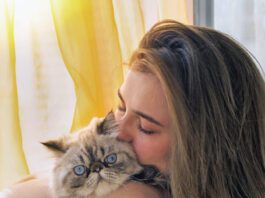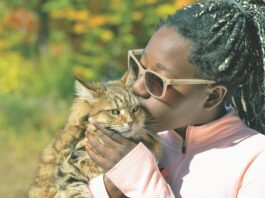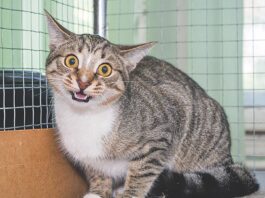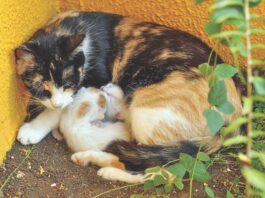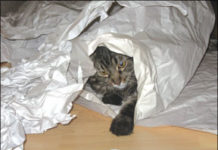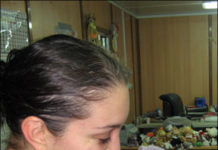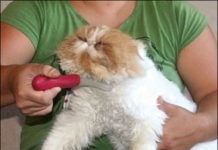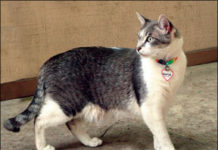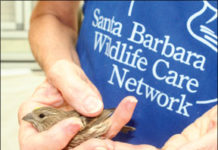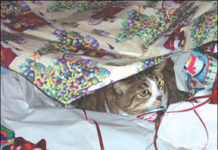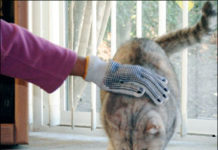Ten Ways to Go Green
It should come as no surprise that Mother Nature is on the verge of taking a permanent sick day. After all, harmful climate changes due to greenhouse gases, air and water pollution, and the destruction of natural habitats are putting our planet and its inhabitants - both two- and four-legged - in peril. Hopefully, many of us have begun to make some changes in our daily lives to help reverse the damage done to, well, everything. But what role can our cats play in being good stewards of our beleaguered planet? There are many practical ways to reduce your felines carbon pawprint, which include switching to a corn or wheat-based cat litter and recycling cat food containers instead of throwing them in the trash. Get a jump start on Earth Day (April 22) by incorporating the following tips into your daily routine. Start out slowly if you wish by trying one or two new tips each week. Encourage your friends, family members and co-workers to join in your quest for a sustainable future. Youll find that its not only fun and easy to "go green," but youll see that you can make a positive and lasting impact on our world, which will please Mother Nature.
Short Takes
A study in the Journal of the American Veterinary Medical Association (Vol. 234, No. 2) found that some dietary supplements dont dissolve fast enough to be absorbed by cats and dogs. The report was titled "Composition, disintegrative properties, and labeling compliance of commercially available taurine and carnitine dietary products" and said that two out of three (labeling and composition) were adequate. Researchers concluded: "Taurine and carnitine products evaluated in this study closely adhered to manufacturer claims and labeling guidelines. However, disintegration testing suggested high variability in some products, possibly limiting uptake and use by animals that receive them."
Pet Care on a Budget
With the economy stumbling, the prospect of hundreds of dollars a year in cat care may seem daunting. But dont worry: There are plenty of ways to defray the cost of owning a cat without compromising your pets well-being. In fact, some of the most effective strategies will actually benefit your cat. As Jodi Korich, DVM, director of Partners in Animal Health at Cornell Universitys College of Veterinary Medicine explains, "One of the best ways to save money on your pets health is to pay attention to early disease detection and preventive health care." Just like oil changes and preventive maintenance result in fewer repair bills for your car, she says, regular check-ups and early intervention will save you money in the long run. Dental hygiene tops Dr. Korichs list of money-saving health care. Dental disease is the most common malady cats suffer, afflicting fifty percent of all cats. Learning to brush your cats teeth at home can make a tremendous difference in your cats oral health. While its not easy to become an expert at cat-brushing, it costs little and can save a lot. Early intervention is equally important. Because you know your cat better than anyone, youre in the best position to spot subtle changes that might indicate a medical problem. Dont ignore something small in the hopes that it will go away because the cost of a cure gets larger the bigger the problem gets. Make it a habit to examine your cat weekly for things like missing hair, skin bumps, tearing eyes or excessive drooling. Keep an eye out for changes in your cats routine, such as a change in appetite or bowel habits.
No Kitty Left Behind: Operation Baghdad Pups
Operation Baghdad Pups, an SPCA International initiative, helps Americans serving in Iraq bring home the animals theyve befriended while on duty. Though at first glance, it might appear that Operation Baghdad Pups is limited to canines, roughly ten percent of the pets in the program are cats. The first cat to come "home" to the states through the program was a small, calico kitten that had been hiding in a trucks engine compartment. Bruce, an American contractor working in Northern Iraq, estimates the kitten was riding in the engine for more than 30 km before she jumped out from under the hood. Alarmed by the kittens serious injuries to one of her front legs, Bruce and a security medic liaison officer treated her "in the field." When she didnt improve after a few days, Bruce took the kitten to the site emergency medical doctor, who gave her further medical treatment. Bruce relates that in an environment in which he had little social contact and spent every waking hour installing "important basic infrastructure" to the local people in Northern Iraq, the little kitten "Hope" filled a void in his life. When the kitten was well enough to venture outside, she quickly befriended the rest of the camp and became a well-loved, affectionate mascot. The day came, of course, when it was time for Bruce to head home; however, he couldnt bear the thought of leaving "Hope" behind. She lacked all survival skills of a feral cat, he explains, and with the emotional attachment he had made during the six months the two had been together, "It would be like me abandoning my own child."
Help for the Matted Cat
While it may seem unlikely to you (given the reputation cats have for personal hygiene and grooming habits), a trip to the groomers can sometimes become necessary for a badly matted cat. There are several factors which can contribute to the matting of a cats haircoat, two ways to deal with it - and one simple way to avoid it in the future. Jana West, owner and operator of Shampooch, located in Savona, NY, has been grooming cats and dogs for eight years. West relates that the most common places for a cat to develop mats are on the back - near the tail, under the belly, along the hind legs and under the tail. She explains that there are three types of cats that [IMGCAP(1)]are more prone to developing mats in their haircoat: "The majority of the cats that have a problem are older cats, bigger cats or cats allowed to spend time outdoors." As cats age, grooming may become less important to them. In addition, cats with a weight issue may have more difficulty reaching certain areas of their bodies. And when it comes to outdoor cats, West adds, "Ideally, all cats would be kept inside and wouldnt come in contact with burrs and branches, but thats not always realistic."
Cat Collars for Safety
As a human companion concerned about your feline, your question should not be if your cat needs a collar - but what type of collar your cat needs. All cats need a collar and an ID tag. That may come as a surprise to you if you keep your cat indoors. But many lost cats were indoor cats at the time they went missing. "Almost half the people who have lost a cat never expected their indoor-only cat to get outside," says Brenda Griffin, DVM, MS, with the Department of Population Medicine and Diagnostic Sciences of Cornell University's College of Veterinary Medicine. Indoor cats get frightened and bolt out of the house, a guest leaves the door open accidentally, your family must vacate the house in an emergency or natural disaster. Anything can happen. An indoor cat that finds itself outside is particularly vulnerable to getting lost and becoming a stray because its not used to being outdoors and finding its way home. Whatever scared your cat in the first place may cause your cat to stay in hiding, not come home or prevent you from finding it. "We strongly encourage people to collar their cats - even if theyre strictly indoor cats," says Brenda Griffin, the veterinarian in charge of initiatives to promote pet ID for both cats and dogs at Cornell University. "We consider an ID collar an essential component of a wellness program for all pet cats (wellness equals preventive medicine)." Outdoor cats are as easily lost. People may think a cat doesnt belong to anyone and may take the cat away from the area. A collar immediately signifies that a cat has a home. If the unthinkable happens and your cat - indoor or outdoor - gets lost, the chances of your cat being found and returned to you are infinitely higher if your cat is wearing some form of ID.
Disaster Help: In the Wake of Hurricane Ike
As a result of Hurricane Ike, the Houston SPCA rescued more than 1800 animals; fed/watered 500 animals that were left in their homes by evacuating families; placed more than 450 pets in temporary foster homes, and celebrated nearly 400 miraculous reunions. Prior to Hurricane Ike making landfall, the Houston SPCA worked in concert with other area shelters: Dogs and cats were relocated from the Houston SPCA to shelters in outlying areas, so that dogs and cats from coastal shelters in danger of destruction could be moved to safety in Houston. In addition, the Houston SPCA coordinated evacuation efforts for owners in need of crates, carriers, muzzles, leashes and other travel items necessary to safely evacuate their beloved pets with them to shelters, hotels and other temporary living arrangements. The question remains, of course, why were so many pets left behind when owners had more than a week to prepare a safe evacuation? Under the Pets Evacuation and Transportation Standards (PETS) Act of 2006, state and local emergency preparedness authorities were required to accommodate households with pets or service animals in their evacuation plans. "The common reasons we heard [for leaving pets behind] were, We didnt think wed be gone so long, We left food on the table, or theyd say, We thought theyd be fine," relates Meera Nandlal, public relations manager for the Houston SPCA in Houston, Texas.
Teaching Your Old Cat New Tricks
We have all heard the popular phrases that support the notion that cats cannot be trained. Tee shirts remind us that "dogs come when called - while cats take a message and get back to us." When a dog is not particularly obedient, he is said to be "more like a cat than a dog." Yet we all know that cats are intelligent and quite capable of learning. In fact, people have successfully trained fruitflies and fish. Perhaps the misconception arose because old-fashioned training strategies which rely on coersion are generally ineffective when used on cats. On the other hand, reward-based training methods are both effective and fun. When an animal (even a cat) is rewarded for demonstrating a particular behavior, he will repeat the behavior in the future. That is the principle of positive reinforcement. A reward-based training technique requires that you find a reinforcer that is truly rewarding. What is your cats pleasure? Is there a treat so delectable that your cat would be willing to jump through a hoop, literally, just for a taste? Consider not only commercial cat treats, but fresh food instead. Morsels of meat, fish, cheese or even cantaloupe can be tested as potential reinforcers.
Ask Elizabeth: 12/08
I do believe that CatWatch readers are the most kind-hearted souls on earth! Thank you for wanting to help these little creatures. Its very common for female cats to bring home prey. Mother cats will first bring home dead animals to their young kittens, teaching them to eat prey animals. When the kittens are a bit older, the moms will bring home wounded animals, and will show the youngsters how to kill. Its possible that Marley is attempting to teach you how to hunt. The best thing that you can do when presented with an injured wild animal is to call a licensed wildlife rehabilitator for advice and assistance. Many well-meaning people are especially tempted to keep baby animals and care for them at home. Keeping wild animals - except to transport them to a wildlife rehabilitator - is against state and federal laws for lots of reasons. Many wild animals, even tiny babies, can transmit diseases to humans or other pets. Diseases, parasites or injuries may be difficult to detect and to treat, and each species requires specialized care.
The Danger of String
Brooke Remy of Boston, MA, was delighted to watch her cat Puddles play with a long, pink ribbon she had just taken off a gift box. He twirled around and around and rolled over on the floor. Brooke tired before Puddles did, and left the room for about five minutes. When she returned, the ribbon was gone - except for about two inches sticking out of Puddless mouth. He was coughing and drooling. Running over to him, Brooke began slowly pulling the ribbon out of his mouth, watching in terror and amazement as she removed eight inches of wet pink ribbon from his throat. Puddles was lucky that Brooke had returned in time. If he had swallowed the ribbon without Brookes quick intervention, he could have suffered very serious, even life-threatening, damage to his intestinal tract.
Ask Elizabeth: 11/08
Dear Elizabeth: I adopted a cat from a local animal shelter three years ago. She is a beautiful brown tabby girl who loves to help when Im working at my desk. The trouble is that she sneezes green goobers all over my paperwork. When I brought her home she had a runny nose and goopy eyes with a lot of sneezing - a classic cat cold according to my veterinarian. A week of antibiotics helped decrease the wet sneezes, but Tabitha has never really recovered from that early cold. Three years have gone by and she still sneezes thick goobers nearly every day. Although she seems happy, is active and eats well, her constant snuffling, congested breathing and spewing green goobers breaks my heart - and also has me frustrated. My veterinarian has done everything she can think of, from antibiotics for weeks on end to medication to help with Tabithas immune system. Everything seems to help … for a while. What tests can I ask for to find out exactly whats causing Tabithas sneezing?
Cleaning Secrets to Try
With three shorthaired and five longhaired cats, Debbie Salerno, chairperson of the board for Maine Coon Cat Rescue in Hazlet, NJ, knows all about cat hair. "I find hair on the steps, on the carpeted cat tree, in the carpet in the hallway, wafting across the floor, and settled into the corners [of rooms] and around the bottom of the furniture," she relates. When hair is not cleaned up, it tends to travel with Salerno to work: "The hair gets all over the furniture and then sticks to me, and it winds up in my car and sometimes in my office if I dont get it off." Admittedly, for some cat owners, wayward hair is not a big issue. For other owners, however, it is. "Cleanliness is a high priority for me," explains Bobbie Williams of Beavercreek, OH. Williams, a volunteer for Maine Coon Rescue, will be hosting a wedding in her home soon and has the hair of four cats (two longhaired and two short-haired) to contend with for this event.


